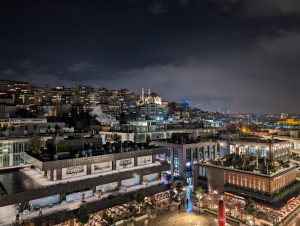Over the past two decades, Grand Canyon tourists and employees were exposed to radiation which was stored in three paint buckets in the national park’s museum collection building in the Grand Canyon Village in Arizona.
The buckets were filled with uranium ore and originally housed in a basement at park headquarters before being moved into the park’s museum collection building in 2000. Apparently, one of the buckets was so full, the lid didn’t even close.
MORE Impacting Travel
It was only in 2018 that federal officials learned the containers were filled with uranium ore, and while they removed the radioactive items, the park’s safety director, Elston “Swede” Stephenson, a former Army helicopter pilot and safety manager in the Navy, says they did nothing to warn or inform park workers or the public that they were exposed to unsafe levels of radiation. So he did something about it.
On February 4th, Stephenson sent an email to all Park Service employees that informed them of the matter and the possible health consequences, as well as alleging a cover-up by federal officials.
“If you were in the Museum Collections Building (2C) between the year 2000 and June 18, 2018, you were ‘exposed’ to uranium by OSHA’s definition,” Stephenson wrote. “The radiation readings, at first blush, exceeds (sic) the Nuclear Regulatory Commission’s safe limits. Identifying who was exposed, and your exposure level, gets tricky and is our next important task.”
Stephenson sent an email to Acting Interior Secretary David Bernhardt and Deputy Inspector General Mary Kendall on February 11, saying that he asked national park executives to inform the public multiple times but was denied each time.
“Respectfully, it was not only immoral not to let our people know,” he added, “but I could no longer risk my (health and safety) certification by letting this go any longer.”
Stephenson claims the containers were stored next to a taxidermy exhibit where children on tours were stopped during presentations that lasted about 30 minutes or more. According to Stephenson, the children would have received radiation dosages that exceed federal safety standards in just three seconds, while adults would have suffered dangerous exposure in less than half of a minute.
Stephenson also calculated that the uranium buckets could have exposed adults to 400 times the health limit and children 4,000 times the safety limit.
Although Stephenson’s announcement to the world will have some panicking, Emily Davis, a public affairs specialist at the Grand Canyon stressed that during a recent review, the building only had background radiation which is natural in the area and safe.
“There is no current risk to the park employees or public,” Davis said. “The building is open. … The information I have is that the rocks were removed, and there’s no danger.”
For nearly two decades at the Grand Canyon, people passed by three paint buckets – unaware that they were being exposed to radiation.https://t.co/NctkCyNIel
— USA TODAY (@USATODAY) February 18, 2019
She also said that Park service is coordinating an investigation with the Occupational Safety and Health Administration (OSHA) and the Arizona Department of Health Services to further see if there is any cause for concern. However, Davis declined to comment on Stephenson’s assertion that thousands were exposed or that Park Service violated the law by not issuing a public warning.
Instead, she said, “We do take our public and employee safety and allegations seriously.”
For Stephenson though, Davis is just one of many trying to cover up how poorly Park Service has handled the situation and exposed employees and tourists to danger.
“I’ve never seen anything like this in my life,” Stephenson told USA Today. He created a 45-slide slideshow detailing the uranium findings, of which included pictures to prove his side of the story.
The uranium was discovered by accident in March 2018 when the teenage son of a park employee was playing with a Geiger counter, or a device that measures radiation, at the museum and noticed odd readings around the buckets. Workers moved the buckets to another location in the building but nothing was done until a few months later, employees told Stephenson about the uranium.
Stephenson called a National Parks Service specialist in Colorado to inform them of the matter and they reached the park on June 18. Oddly, they arrived without protective clothing and instead used dishwashing and gardening gloves and a broken mop handle to lift the buckets into a truck. Stephenson took pictures to document everything.
Stephenson said the technicians dumped the ore into Orphan Mine, an old uranium dig, two miles from Grand Canyon Village and wouldn’t tell him what the radiation readings of the buckets were.
Not feeling good about the experience, he drove to Phoenix in November and filed a report with OSHA and they sent inspectors to the building where they detected a low-level site, tracing their readings to the three buckets that the Park Service technicians had returned to the building after they dumped the ore in the mine.
“You could hear their meters going off,” Stephenson said.
Davis of the Park Service declined to comment on this finding which clashes with her statement that a recent review only found “background radiation,” while OSHA would only confirm an investigation is underway.
Stephenson says that high-level officials and the Park Service are trying to cover up the radiation exposure and that a “Right to Know” law demands the public knows about the risk.
“My first interest is the safety of the workers and the people,” he said.
In an effort to do his job and protect employees and tourists, Stephenson worked to obtain a report submitted by the Park Service’s regional safety manager which confirms the area was “positive for radioactivity above background” with high levels near the taxidermy area.
The report stated that radiation levels were 13.9 millirems per hour where the buckets were stored, 800 per hour on contact with the uranium and a zero reading five feet from the buckets. The Nuclear Regulatory Commission claims that 2 millirems per hour and less is the maximum safe dosage for the public.
The report did not call for notifying the public, only mentioned how geology samples should be handled in the future.
DHS and EPA get big appropriations to maintain radiological emergency response teams, write manuals, hold training sessions for local cops/EMS, etc. Come to cases, though, a radiological emergency at a federal facility is handled with store-bought gloves and a broken mop handle. pic.twitter.com/sB5GT5Ajap
— southpaw (@nycsouthpaw) February 18, 2019
This was not enough for Stephenson. He tried to get park superintendents to take action, filed an inspector general complaint, contacted the FBI and wrote to every member of Congress.
When nothing was done, Stephenson wrote the letter to colleagues on February 4, apologizing and stressing that exposure may not be severe unless they got close to the uranium and were exposed to it long periods of time, adding that other factors may come into play. He added that they might not necessarily suffer health consequences but may want to get medically screened.
“Of particular concern are 1000s of children attending ‘shows’ in very close proximity to the uranium,” he wrote.
Since blowing the whistle to his employees, Stephenson hasn’t heard anything from Park Service supervisors.
“They’re in cover-up mode,” he said. “I’ve been cut off from any kind of information.”




















